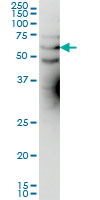KCNA3 Antibody (monoclonal) (M01)
Mouse monoclonal antibody raised against a partial recombinant KCNA3.
- 产品详情
- 实验流程
- 背景知识
Application
| WB, E |
|---|---|
| Primary Accession | P22001 |
| Other Accession | BC035059 |
| Reactivity | Human |
| Host | mouse |
| Clonality | monoclonal |
| Isotype | IgG1 Kappa |
| Clone Names | 1D8 |
| Calculated MW | 63842 Da |
| Gene ID | 3738 |
|---|---|
| Other Names | Potassium voltage-gated channel subfamily A member 3, HGK5, HLK3, HPCN3, Voltage-gated K(+) channel HuKIII, Voltage-gated potassium channel subunit Kv13, KCNA3, HGK5 |
| Target/Specificity | KCNA3 (AAH35059, 424 a.a. ~ 523 a.a) partial recombinant protein with GST tag. MW of the GST tag alone is 26 KDa. |
| Dilution | WB~~1:500~1000 E~~N/A |
| Format | Clear, colorless solution in phosphate buffered saline, pH 7.2 . |
| Storage | Store at -20°C or lower. Aliquot to avoid repeated freezing and thawing. |
| Precautions | KCNA3 Antibody (monoclonal) (M01) is for research use only and not for use in diagnostic or therapeutic procedures. |
For Research Use Only. Not For Use In Diagnostic Procedures.
Provided below are standard protocols that you may find useful for product applications.
BACKGROUND
Potassium channels represent the most complex class of voltage-gated ion channels from both functional and structural standpoints. Their diverse functions include regulating neurotransmitter release, heart rate, insulin secretion, neuronal excitability, epithelial electrolyte transport, smooth muscle contraction, and cell volume. Four sequence-related potassium channel genes - shaker, shaw, shab, and shal - have been identified in Drosophila, and each has been shown to have human homolog(s). This gene encodes a member of the potassium channel, voltage-gated, shaker-related subfamily. This member contains six membrane-spanning domains with a shaker-type repeat in the fourth segment. It belongs to the delayed rectifier class, members of which allow nerve cells to efficiently repolarize following an action potential. It plays an essential role in T-cell proliferation and activation. This gene appears to be intronless and it is clustered together with KCNA2 and KCNA10 genes on chromosome 1.
REFERENCES
Activated T-cells inhibit neurogenesis by releasing granzyme B: rescue by Kv1.3 blockers. Wang T, et al. J Neurosci, 2010 Apr 7. PMID 20371822.A folding zone in the ribosomal exit tunnel for Kv1.3 helix formation. Tu LW, et al. J Mol Biol, 2010 Mar 12. PMID 20060838.[Kv1.3 potassium channel expression changes after CD4(+) and subsets CD28(null)/CD28(+)T cells activation in peripheral blood of patients with acute coronary syndrome] Feng DY, et al. Zhonghua Xin Xue Guan Bing Za Zhi, 2009 Jul. PMID 19961728.Differential calcium signaling and Kv1.3 trafficking to the immunological synapse in systemic lupus erythematosus. Nicolaou SA, et al. Cell Calcium, 2010 Jan. PMID 19959227.Aberrant modulation of a delayed rectifier potassium channel by glutamate in Alzheimer's disease. Poulopoulou C, et al. Neurobiol Dis, 2010 Feb. PMID 19850126.
终于等到您。ABCEPTA(百远生物)抗体产品。
点击下方“我要评价 ”按钮提交您的反馈信息,您的反馈和评价是我们最宝贵的财富之一,
我们将在1-3个工作日内处理您的反馈信息。
如有疑问,联系:0512-88856768 tech-china@abcepta.com.























 癌症的基本特征包括细胞增殖、血管生成、迁移、凋亡逃避机制和细胞永生等。找到癌症发生过程中这些通路的关键标记物和对应的抗体用于检测至关重要。
癌症的基本特征包括细胞增殖、血管生成、迁移、凋亡逃避机制和细胞永生等。找到癌症发生过程中这些通路的关键标记物和对应的抗体用于检测至关重要。 为您推荐一个泛素化位点预测神器——泛素化分析工具,可以为您的蛋白的泛素化位点作出预测和评分。
为您推荐一个泛素化位点预测神器——泛素化分析工具,可以为您的蛋白的泛素化位点作出预测和评分。 细胞自噬受体图形绘图工具为你的蛋白的细胞受体结合位点作出预测和评分,识别结合到自噬通路中的蛋白是非常重要的,便于让我们理解自噬在正常生理、病理过程中的作用,如发育、细胞分化、神经退化性疾病、压力条件下、感染和癌症。
细胞自噬受体图形绘图工具为你的蛋白的细胞受体结合位点作出预测和评分,识别结合到自噬通路中的蛋白是非常重要的,便于让我们理解自噬在正常生理、病理过程中的作用,如发育、细胞分化、神经退化性疾病、压力条件下、感染和癌症。










